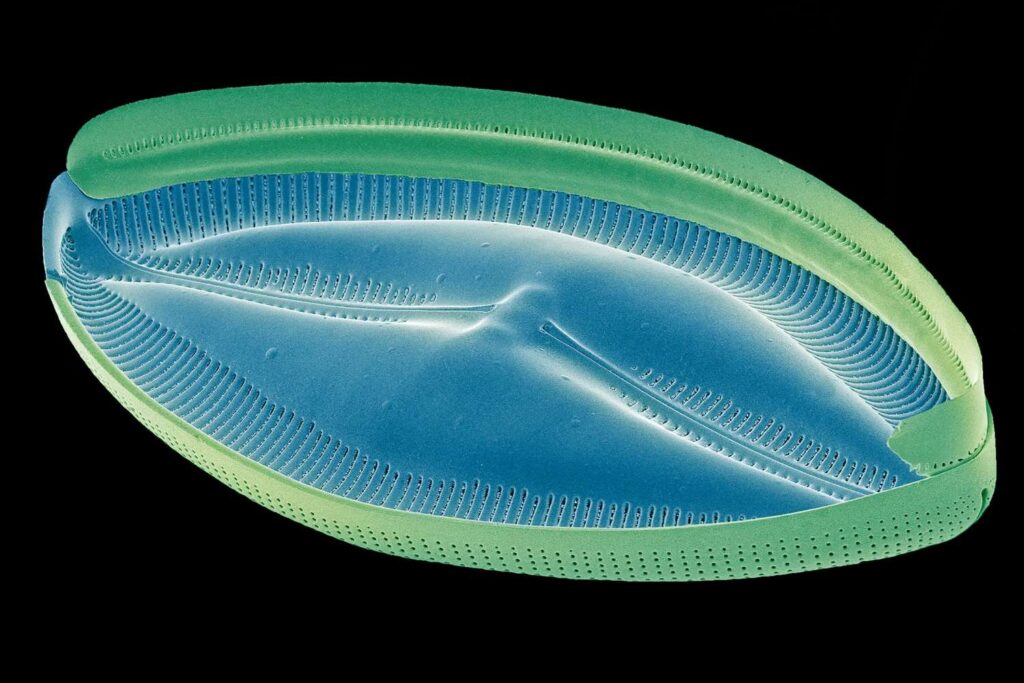🧬 KINGDOM PROTISTA
- Term Protista given by E. Haeckel.
- Organisms included in Protista are unicellular (acellular) eukaryotes.
🔹 Main Groups of Protista
- Autotrophic / Photosynthetic organisms
→ Dinoflagellates, Diatoms, Euglenoids - Consumer–Decomposer organisms (Absorptive)
→ Slime moulds - Protozoans
→ Zooflagellates, Sarcodines, Sporozoans, Ciliates
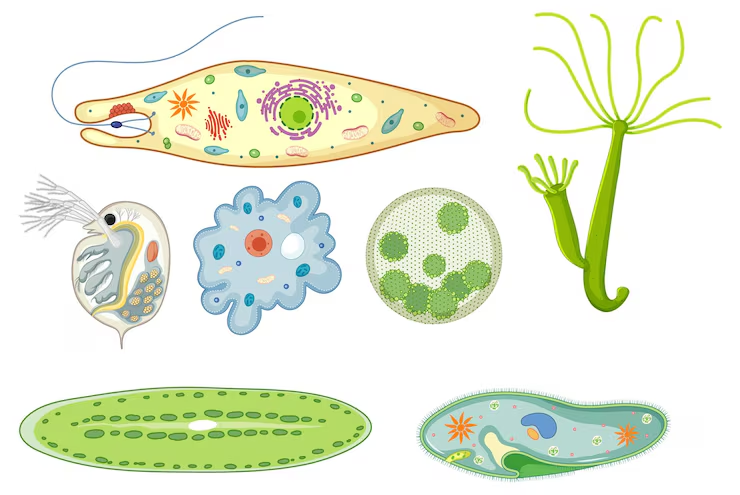
🍃 NUTRITION IN PROTISTS
- Holophytic / Photosynthetic – prepare own food via photosynthesis (chloroplast + pigments).
→ e.g., Diatoms - Holozoic – animal-like; food ingested and digested.
→ e.g., Noctiluca (Dinoflagellate) - Absorptive / Saprophytic – obtain food from dead organic matter via extracellular enzymes.
→ Enzymes convert complex substances → simple ones → absorbed through body surface. - Mixotrophic – both holophytic and holozoic.
→ e.g., Ceratium, Euglena
🌱 REPRODUCTION IN PROTISTS
Asexual reproduction – most common, occurs in favourable conditions:
- Binary fission – single mother cell → two daughter cells.
- Spore formation – spores produced inside sporangia.
Sexual reproduction – first appeared in Protists.
- Involves fusion of haploid gametes → diploid zygote (syngamy).
- Types of Syngamy:
- Isogamy: gametes morphologically similar, may be physiologically dissimilar → physiological anisogamy.
- Anisogamy: gametes morphologically & physiologically dissimilar (small motile male, large immotile female).
- Oogamy: advanced anisogamy; male = small & motile sperm, female = large & immotile egg (formed in sex organs).
🔄 LIFE CYCLES OF PROTISTS
1. Haplontic Life Cycle
- Organism haploid, meiosis occurs in zygote → zygotic meiosis.
- Only zygote is diploid, all other stages haploid.
- e.g., Ceratium, Gymnodinium, Cellular slime moulds.
2. Diplontic Life Cycle
- Organism diploid, meiosis occurs during gamete formation → gametic meiosis.
- Only gametes are haploid; rest all stages diploid.
- e.g., Noctiluca, Diatoms, Acellular slime moulds.
🔸 DINOFLAGELLATES
- Division: Pyrrophyta
- Class: Dinophyceae
- Biflagellated photosynthetic protists, mostly marine, found on water surface.
- Golden brown due to pigments.
Structure:
- Body covered by rigid theca / lorica (cellulose + pectin plates) → “armoured dinoflagellates”.
- Two flagella: one transverse, one longitudinal → movement called “whorling whips” → hence “whorling whip flagellates.”
- Haploid; histone protein absent → called mesokaryotes.
- Have osmoregulatory organelle = pusule (non-contractile vacuole).
- Colour: yellow/golden-brown due to Chl a, Chl c, α-carotene, Xanthophylls.
- Stored food: starch.
Nutrition:
- Mostly holophytic (photosynthetic).
- e.g., Ceratium, Gonyaulax, Gymnodinium, Pyrocystis.
Special Cases:
- Noctiluca: colourless, chloroplast absent → holozoic; diploid, diplontic life cycle; shows bioluminescence → “Sea ghost.”
- Ceratium: mixotrophic.
Reproduction:
- Mainly asexual (binary fission);
- Sexual reproduction rare, involves zygotic meiosis → haplontic life cycle (except Noctiluca).
Special Features:
- Many (e.g., Noctiluca, Gonyaulax, Pyrocystis) show bioluminescence.
- Contain luciferin protein → oxidation → light release (at night).
- Called “Fire algae / Night light”.
- Gonyaulax causes Red tide (sea water appears red).
- Gymnodinium & Gonyaulax secrete saxitoxin → paralysis in humans (via food chain).
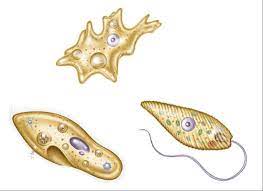
🌊 DIATOMS
- Division: Bacillariophyta
- Class: Bacillariophyceae
- Also called Golden algae or Jewels of the Sea.
- “Diatom” = “cut in two” → due to 2-parted wall.
- Holophytic mode of nutrition (chloroplast present).
- e.g., Navicula, Cyclotella, Pinnularia.
Structure:
- Shapes: circular, rectangular, triangular, elongated, boat-shaped.
- Unicellular, may form colonies/pseudofilaments.
- Lack flagella (except in reproduction).
- Cell wall = cellulose + silica → transparent frustule (2 halves: epitheca over hypotheca, like a soap box).
- Dead diatoms → form diatomite / diatomaceous earth / kieselguhr (accumulated silica shells).
- Diploid nucleus present.
Pigments & Nutrition:
- Pigments: Chl a, Chl c, fucoxanthin (xanthophyll) → golden-brown colour.
- Stored food: Leucosin (Chrysolaminarin) + fats/oil.
- Float on water (due to fats).
Reproduction:
- Asexual: binary fission; one half wall retained by each daughter, new half secreted.
- Sexual (rare): gametic meiosis (diplontic); zygote = auxospore; resting spores = statospores.
Uses:
- Soundproofing, filtration of oil, polishing stone, pollution indicator, heat insulation (steam boilers).
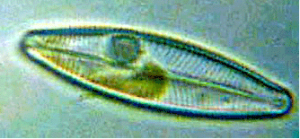
🌿 EUGLENOIDS
- Division: Euglenophyta
- Class: Euglenophyceae
- Previously placed in Plant kingdom (due to chlorophyll), later in Protista (animal-like nutrition).
- Mode of nutrition: mixotrophic (holophytic + holozoic + saprophytic).
- e.g., Euglena, Paranema.
Structure:
- No cell wall, covered by pellicle (lipoprotein, elastic).
- Reservoir at anterior end; flagellum arises from it.
- One functional flagellum; contractile vacuole present (osmoregulation).
Nutrition:
- Pigments: Chl a, Chl b, Xanthophyll (Zeaxanthin).
- Stored food: Paramylum (β-1,3-glucan) + fats.
- Movement: Euglenoid (wriggling) movement via pellicle; both flagellated and non-flagellated types.
Reproduction:
- Asexual: longitudinal binary fission.
- Unfavourable conditions: form palmella stage / cysts for perennation.
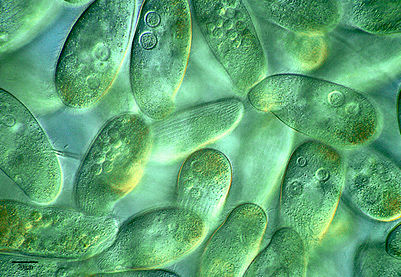
🍄 SLIME MOULDS
- Division: Mastigomycotina
- Class: Gymnomycota
- Also known as Consumer–Decomposer protists or False fungi.
- Found on decaying leaves/stems; saprophytic.
- Called “Fungus-animals” (share traits with both).
Animal-like Characters:
- Surrounded by cell membrane, amoeboid body, phagotrophic nutrition.
Fungal-like Characters:
- Cell wall formation, sporangia during reproduction, absorptive/saprotrophic nutrition.
Types (based on structure):
Acellular / Plasmodial Slime Moulds
- Body = wall-less multinucleated protoplasmic mass (plasmodium).
- Plasmodium forms fructifications (fruiting bodies).
- Wall of sporangium = peridium; inside = capillitium (network of threads).
- Each nucleus diploid.
- e.g., Physarum, Stemonitis, Physarella, Fuligo.
Cellular Slime Moulds
- Body = many wall-less amoeboid cells (not fused) → pseudoplasmodium / myxamoeba.
- Each cell haploid.
- Show primitive multicellularity & division of labour → “communal slime moulds.”
- e.g., Dictyostelium, Protostelium, Acytostelium.
Reproduction:
- Asexual: via spore formation in sporangia (capillitium / fruiting body).
Sexual:
- Acellular slime moulds → diploid, reproduce via gametic meiosis → diplontic life cycle.
- Cellular slime moulds → haploid, reproduce via zygotic meiosis → haplontic life cycle.
Protozoans
- All protozoans are heterotrophs and live as predators or parasites.
- They are believed to be primitive relatives of animals.
- There are four major groups of protozoans.
Amoeboid protozoans
- These organisms live in fresh water, sea water or moist soil.
- They move and capture their prey by putting out pseudopodia (false feet) as in Amoeba.
- Marine forms have silica shells on their surface.
- Some of them such as Entamoeba are parasites.
Flagellated protozoans
- The members of this group are either free-living or parasitic.
- They have flagella.
- The parasitic forms cause diseases such as sleeping sickness.
- Example: Trypanosoma.
Ciliated protozoans
- These are aquatic, actively moving organisms because of the presence of thousands of cilia.
- They have a cavity (gullet) that opens to the outside of the cell surface.
- The coordinated movement of rows of cilia causes the water laden with food to be steered into the gullet.
- Example: Paramoecium

.
.
Sporozoans

- This includes diverse organisms that have an infectious spore-like stage in their life cycle.
- The most notorious is Plasmodium (malarial parasite), which causes malaria, a disease which has a staggering effect on human population.
📌 POINTS TO REMEMBER
- Some unicellular eukaryotic algae may be considered under Protista, e.g., Chlorella, Acetabularia, Chlamydomonas, Trebauxia.
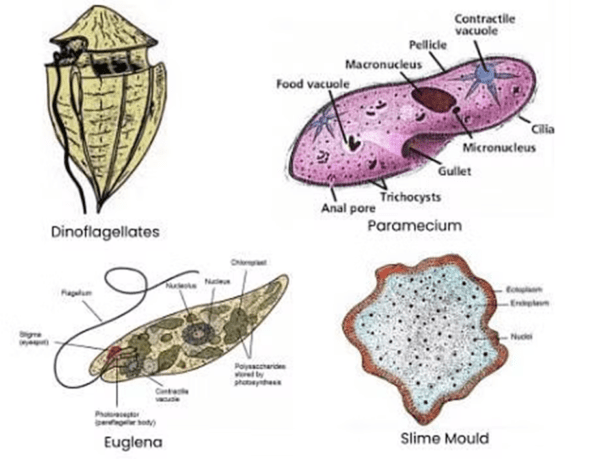
Practice Questions
- Assertion (A): Protists form a diverse kingdom because they show features of both plants, animals, and fungi.
Reason (R): They are eukaryotic organisms that may be autotrophic like algae or heterotrophic like protozoa and slime molds.
(a) Both A and R are true, and R is the correct explanation of A.
(b) Both A and R are true, but R is not the correct explanation of A.
(c) A is true, but R is false.
(d) A is false, but R is true.
Answer: (a)
2. Assertion (A): Slime molds are called saprophytic protists.
Reason (R): They feed on decaying organic matter by forming plasmodium, a mass of multinucleated protoplasm that engulfs particles.
(a) Both A and R are true, and R is the correct explanation of A.
(b) Both A and R are true, but R is not the correct explanation of A.
(c) A is true, but R is false.
(d) A is false, but R is true.
Answer: (a)
3. Assertion (A): Slime molds are unique because they resemble both protozoa and fungi during different stages of their life cycle.
Reason (R): They exist as motile amoeboid cells during feeding and form stationary sporangia during reproduction.
(a) Both A and R are true and R is the correct explanation of A.
(b) Both A and R are true but R is not the correct explanation of A.
(c) A is true but R is false.
(d) A is false but R is true.
Answer: (a)
4. Assertion (A): Diatoms are called “pearls of the ocean” because of their beautiful siliceous walls.
Reason (R): Their cell walls are made up of cellulose and pectin which dissolve easily in water, contributing to the marine sediment.
(a) Both A and R are true and R is the correct explanation of A.
(b) Both A and R are true but R is not the correct explanation of A.
(c) A is true but R is false.
(d) A is false but R is true.
Answer: (c)
5. Assertion (A): Dinoflagellates often exhibit bioluminescence in the sea.
Reason (R): They possess luciferin-luciferase enzyme systems that produce light during oxidation reactions.
(a) Both A and R are true and R is the correct explanation of A.
(b) Both A and R are true but R is not the correct explanation of A.
(c) A is true but R is false.
(d) A is false but R is true.
Answer: (a)
6. Assertion (A): Euglena is a connecting link between plants and animals.
Reason (R): It contains chloroplasts and can perform photosynthesis in light but behaves as heterotroph in darkness.
(a) Both A and R are true and R is the correct explanation of A.
(b) Both A and R are true but R is not the correct explanation of A.
(c) A is true but R is false.
(d) A is false but R is true.
Answer: (a)
7. Assertion (A): The protist Euglena is considered mixotrophic because it can switch between phototrophy and heterotrophy depending on environmental conditions.
Reason (R): Euglena contains chloroplasts with chlorophyll-a and -b and paramylum as reserve carbohydrate, yet lacks a rigid cell wall and can ingest food when light is limiting.
(a) Both A and R are true and R is the correct explanation of A.
(b) Both A and R are true but R is not the correct explanation of A.
(c) A is true but R is false.
(d) A is false but R is true.
Answer: (a)
8. Assertion (A): Diatoms are important contributors to marine sediments because their silica-rich cell walls accumulate as diatomaceous earth.
Reason (R): Their frustules composed of silica (SiO₂) resist rapid decomposition, and when diatoms die their siliceous remains settle to form siliceous deposits.
(a) Both A and R are true and R is the correct explanation of A.
(b) Both A and R are true but R is not the correct explanation of A.
(c) A is true but R is false.
(d) A is false but R is true.
Answer: (a)
9. Diatoms contribute significantly to marine productivity because
(a) Their chlorophyll and carotenoids capture sunlight efficiently and their siliceous frustules ensure buoyancy.
(b) They depend on dissolved organic matter for food.
(c) They are heterotrophic decomposers.
(d) They lack photosynthetic pigments.
Answer: (a)
10. The term “slime mold” reflects organisms that
(a) Exhibit both animal-like amoeboid feeding and fungal-like spore production.
(b) Show only parasitic nutrition.
(c) Are unicellular parasites of algae.
(d) Are green photosynthetic protists.
Answer: (a)
11. Dinoflagellates are often responsible for red tides because
(a) Under favorable conditions, their population explodes, releasing pigments and toxins in seawater.
(b) They possess siliceous shells that color the water.
(c) They live symbiotically with corals.
(d) They feed on phytoplankton blooms.
Answer: (a)
12. Which feature best distinguishes euglenoids from green algae?
(a) Presence of flexible pellicle instead of a cellulose wall and mixotrophic nutrition.
(b) Occurrence of true starch grains as reserve food.
(c) Absence of chlorophyll-b.
(d) Multicellular organization.
Answer: (a)
13. Protozoa differ from other protists in
(a) Being unicellular heterotrophs showing locomotion by pseudopodia, cilia, or flagella.
(b) Possessing chloroplasts with double membranes.
(c) Showing alternation of generations.
(d) Forming multicellular thalli.
Answer: (a)
14. The main reason for difficulty in classifying protists is
(a) They exhibit both plant-like and animal-like traits in a single organism.
(b) They all reproduce only sexually.
(c) They are completely autotrophic.
(d) They lack genetic material.
Answer: (a)
15. Slime molds occupy an intermediate position between protozoa and fungi.
Their feeding stage resembles an amoeba, while their reproductive stage forms sporangia that release spores.
(a) They are true fungi forming hyphae and mycelium.
(b) They are photosynthetic protists.
(c) They exhibit characteristics of both protozoa and fungi.
(d) They are parasitic protozoans.
Answer: (c)
16. Diatoms are among the most important primary producers in aquatic ecosystems because of their photosynthetic efficiency and siliceous shells.
After death, their indestructible frustules accumulate as diatomaceous earth, widely used in filtration and insulation industries.
(a) Diatoms are parasitic unicellular animals.
(b) Their cell wall is made of cellulose and protein.
(c) Their shells form deposits known as diatomite.
(d) They reproduce by budding.
Answer: (c)
17. The periodic appearance of red tides in coastal regions is due to massive growth of certain dinoflagellates such as Gonyaulax.
These organisms produce toxins that can kill marine fish and invertebrates, disturbing ecological balance.
(a) Dinoflagellates are always beneficial symbionts.
(b) Red tides occur due to viral infections in corals.
(c) Rapid multiplication of toxic dinoflagellates causes discoloration of seawater.
(d) Cyanobacteria release pigments that turn the water red.
Answer: (c)
18. Euglenoids show remarkable adaptability in their mode of nutrition.
When sufficient light is available, they photosynthesize; under darkness, they feed on dissolved organic matter.
(a) Euglenoids are strict autotrophs.
(b) They show both autotrophic and heterotrophic nutrition.
(c) They cannot live without light.
(d) They reproduce only by spores.
Answer: (b)
19. In the life cycle of Plasmodium, alternation between human and mosquito hosts ensures genetic variation and survival of the parasite.
Asexual multiplication occurs in the human host, while sexual reproduction occurs in the mosquito.
(a) Sexual reproduction occurs in humans.
(b) Asexual reproduction occurs in mosquitoes.
(c) Both sexual and asexual stages occur in the mosquito.
(d) Sexual reproduction occurs in mosquitoes, asexual in humans.
Answer: (d)
20. In protists such as paramecium, contractile vacuoles perform osmoregulation, preventing the cell from bursting in hypotonic environments.
This adaptation maintains ionic balance and internal stability.
(a) Contractile vacuoles remove excess water.
(b) They store food granules.
(c) They secrete digestive enzymes.
(d) They aid in reproduction.
Answer: (a)
21. Which of the following statements regarding Protista are true?
(i) They include unicellular eukaryotic organisms.
(ii) They may be autotrophic or heterotrophic.
(iii) Slime molds are included in this kingdom.
(iv) They reproduce only sexually.
(a) (i), (ii), and (iii) only
(b) (ii) and (iv) only
(c) (i) and (ii) only
(d) All of these
Answer: (a)
22. Which of the following statements about Dinoflagellates are correct?
(i) They possess two flagella placed in perpendicular grooves.
(ii) Their cell wall is made of cellulose plates.
(iii) Some are bioluminescent and cause red tides.
(iv) They lack chlorophyll.
(a) (i), (ii), and (iii) only
(b) (ii) and (iv) only
(c) (i) and (iii) only
(d) All of these
Answer: (a)
23. Which of the following are true for Diatoms?
(i) Their cell walls form two overlapping halves called frustules.
(ii) Their walls are impregnated with silica.
(iii) They are chief producers in oceans.
(iv) Their cell wall dissolves easily in water.
(a) (i), (ii), and (iii) only
(b) (ii) and (iv) only
(c) (i) and (iv) only
(d) All of these
Answer: (a)
24. Which of the following statements about Euglenoids are correct?
(i) They possess chlorophyll-a and chlorophyll-b.
(ii) Their body is covered by a flexible pellicle instead of cell wall.
(iii) They are photosynthetic only.
(iv) They can survive as heterotrophs in darkness.
(a) (i), (ii), and (iv) only
(b) (ii), (iii), and (iv) only
(c) (i) and (ii) only
(d) All of these
Answer: (a)
25. Which of the following statements regarding Slime Molds are correct?
(i) They feed on decaying organic matter.
(ii) The vegetative phase is a plasmodium.
(iii) They reproduce sexually only.
(iv) Sporangia are formed in unfavorable conditions.
(a) (i), (ii), and (iv) only
(b) (ii), (iii), and (iv) only
(c) (i) and (ii) only
(d) All of these
Answer: (a)
For More Questions:- https://studynest.ibiokaare.com/
For Online class :- https://www.ibiokaare.com/
For Notes and PDF :- https://www.ibiokaare.com/
Latest Research, News, Articles on biology at :- https://www.akbbiology.com/
